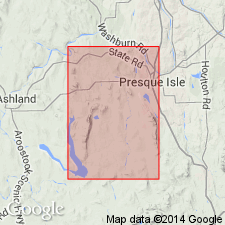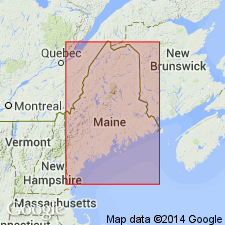
- Usage in publication:
-
- Matagamon formation
- Modifications:
-
- First used
- Dominant lithology:
-
- Subgraywacke
- AAPG geologic province:
-
- New England province
Summary:
Pg. 95. Matagamon formation. Formation is oldest unit in Traveler Mountain area, north-central Maine. A marine subgraywacke of Becraft-Oriskany age. Overlain by 8,500 feet of felsitic flows, tuff, and welded tuff which Toppan (1932) originally named Traveler [Traveller] rhyolite. Age is Early Devonian.
Source: US geologic names lexicon (USGS Bull. 1350, p. 475).

- Usage in publication:
-
- Matagamon Sandstone*
- Modifications:
-
- Named
- Biostratigraphic dating
- Dominant lithology:
-
- Slate
- Siltstone
- Sandstone
- AAPG geologic province:
-
- New England province
Summary:
Named for Grand Lake Matagamon. Type section is on west slope of Hay Mountain, north of Grand Lake Road (southeast of Grand Lake Matagamon). Occurs in the area southeast of Grand Lake Matagamon to the area around Hay Lake and Atwood Pond in the Traveller Mountain and Shin Pond 15-min quads, Penobscot County, northern Maine. Consists of medium bluish-gray or greenish-gray, fine-grained, slightly calcareous, thickly bedded, rusty weathering sandstone; also includes minor amount of dark slate and argillaceous siltstone interbedded with sandstone. Terrane is characterized by low hogback ridges. Thickness estimated between 4,000 to 5,000 feet. Conformably underlies Traveller Rhyolite of Toppan (1932) (contact is gradational). Age is Early Devonian, based on brachiopod CLOUDELLA MATAGAMONI Boucot taken from sandstone at Grand Lake Dam; also LEPTOCOELIA cf. L. FLABELLITES, LEPTOSTROPHIA? sp., and MERISTELLA sp. from lower Stair Falls suggest a Becraft or Oriskany age. Other fossils and stratigraphic position support the Early Devonian age. Report includes geologic map.
Source: GNU records (USGS DDS-6; Reston GNULEX).

- Usage in publication:
-
- Matagamon Sandstone*
- Modifications:
-
- Overview
- AAPG geologic province:
-
- New England province
Summary:
Used as Matagamon Sandstone of Devonian (Siegenian) age. Overlies rocks of the Seboomook Group. Shown only on stratigraphic section (fig. 2).
Source: GNU records (USGS DDS-6; Reston GNULEX).
For more information, please contact Nancy Stamm, Geologic Names Committee Secretary.
Asterisk (*) indicates published by U.S. Geological Survey authors.
"No current usage" (†) implies that a name has been abandoned or has fallen into disuse. Former usage and, if known, replacement name given in parentheses ( ).
Slash (/) indicates name conflicts with nomenclatural guidelines (CSN, 1933; ACSN, 1961, 1970; NACSN, 1983, 2005, 2021). May be explained within brackets ([ ]).

